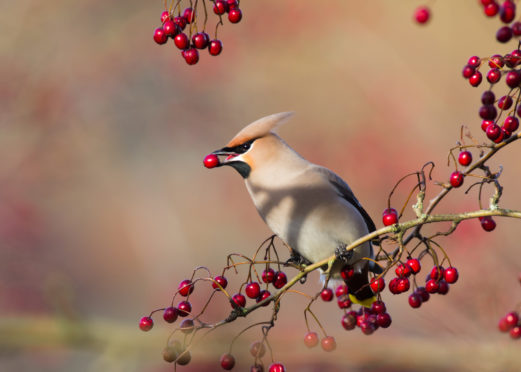I had just spotted a flock of waxwings in a tree in the front garden of a house in Milnathort, which was like hitting a wildlife jackpot – but it did present a bit of a dilemma.
I was keen to snap some photographs of these scarce and beautiful birds, but the tree branches holding the waxwings overhung an upstairs window, and the potential scenario of the lady of the house looking out to see a strange man in the street below pointing a telephoto lens at her didn’t really bear thinking about.
But then again, these opportunities don’t come often, so I rattled off a few quick shots, before retreating back to the car where I could observe these Kinross-shire waxwings in relative obscurity. And what stunning birds they were, with their Mohican-like crests, pinkish bodies and intricately patterned black, white, yellow and red wing edges.
Slightly smaller than a starling, waxwings are irregular winter visitors to our shores from their breeding grounds in the boreal forests of northern Scandinavia and Russia. Some winters they are almost absent, but in others reasonable numbers descend upon the east coast where they favour the gardens of our towns and cities to feast upon the abundance of berries growing on native and ornamental trees.
Rowan berries are a particular favourite and in years where the northern crop is poor, then in sweep the waxwings to the British Isles – and this appears to be a good winter for them.
There are many other colourful winter visitors about too at the moment, and a few days before my waxwing encounter, I was in Angus visiting the RSPB Loch of Kinnordy reserve near Kirriemuir. I adore this place because there is always an abundance of waterfowl and the surrounding woodland is a great place for spotting red squirrels and song birds.
Soon after my arrival, I settled down into one of the hides overlooking the water and as ever, I wasn’t disappointed. A drake wigeon immediately floated into view and there were teal about too. Teal are wonderful little ducks, always wary and hard to approach, but with a real zest for life as they busily feed in the loch shallows.
Such is my passion for teal that in my home area of Strathdevon, I often venture down to the local river at this time of year to watch them flying-in to the haugh at dusk to feed in the rushy pools. It is a wonderful experience to stand hidden amongst trees overlooking these damp fields, the air still and the light fading. Then, in they come, small flights of ducks circling above the pastel gloaming before splashing down into the water.
As I head for home under the cloak of darkness, I can still hear their piping whistles, a delicate caress of the cold night air. It is such a gentle call, and the very encapsulation of winter down by the river.
Info
Waxwings can turn up in virtually any part of Courier Country, but good traditional spots for them include Montrose, Arbroath and Dundee, as well as towns and parks in Fife and Kinross-shire.










